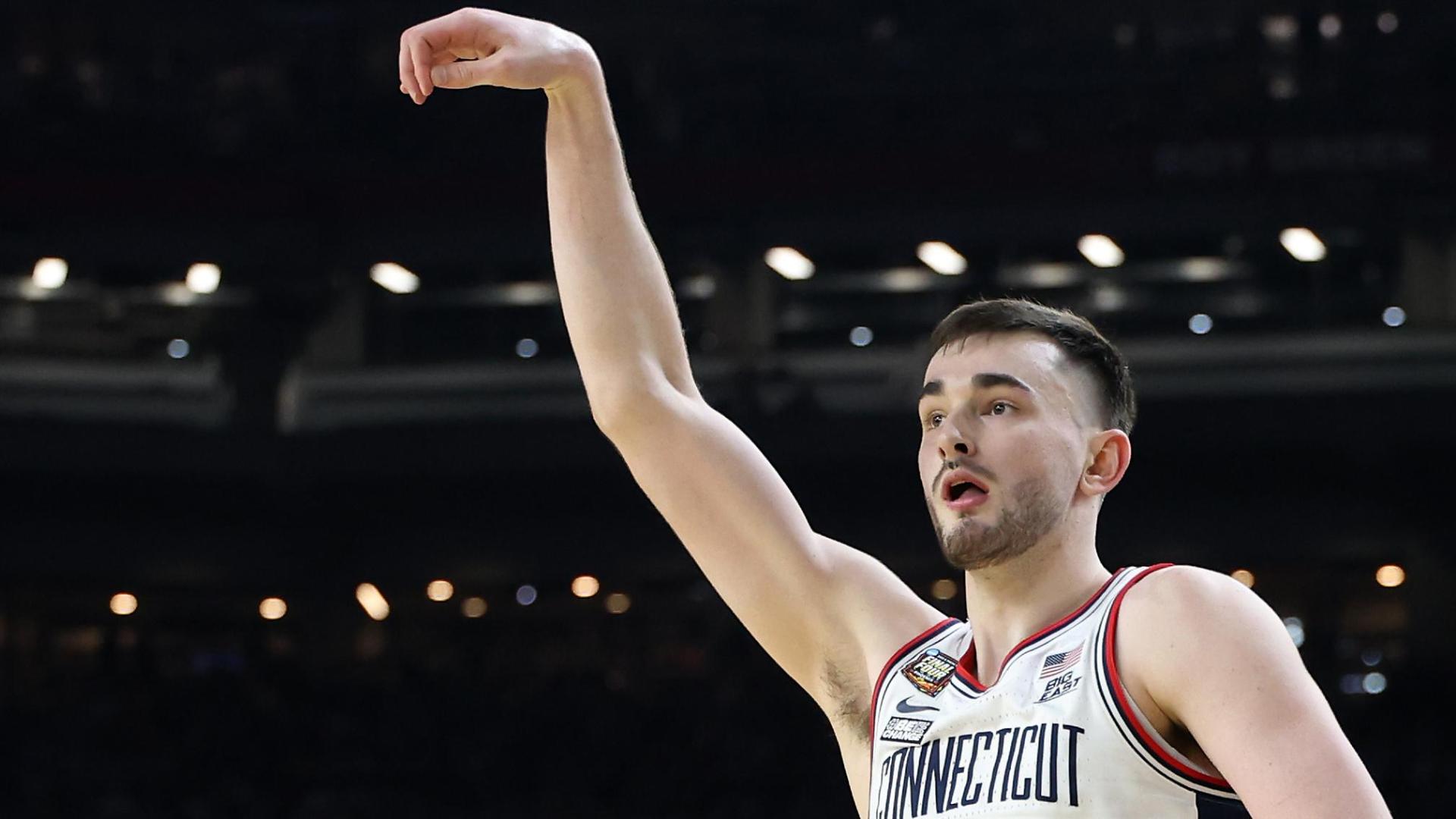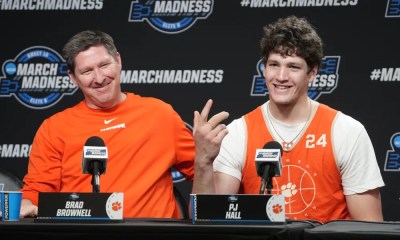
Can UConn three-peat? Without a doubt, yes, they can contend for a three-peat. However, significant reinforcements will be necessary, in my view. In this portal era, it’s entirely conceivable that UConn could forge another championship-caliber team from scratch, particularly buoyed by the momentum gained from one of the most dominant championship runs in NCAA history. A plethora of top-tier players are likely to gravitate towards joining them over other options. Unlike the previous championship season, where Dan Hurley had to navigate uncertainties regarding multiple players potentially entering the draft that were in limbo and staying in the process with no quick resolution, this season’s needs appear more straightforward. He will possess a clearer understanding of where his returners are and his requirements and a swifter start to the rebuilding process.
Likely Rotation as of Today
| Key Returners | RSCI | PER | ||||
|---|---|---|---|---|---|---|
| C | Samson Johnson | JR | 6-10 | 47 (2021) | 5.4 Pts, 2.8 Reb, 0.5 Ast | 17.0 |
| PF | Alex Karaban | SO | 6-8 | 13.3 Pts, 5.1 Reb, 1.5 Ast | 20.3 | |
| SF | Jaylin Stewart | FR | 6-7 | 65 (2023) | 2.5 Pts, 1.2 Reb, 0.3 Ast | 11.2 |
| SG | Solomon Ball | FR | 6-3 | 43 (2023) | 3.3 Pts, 1.0 Reb, 0.3 Ast | 8.5 |
| PG | Hassan Diarra | SR | 6-2 | 64 (2020) | 6.1 Pts, 3.0 Reb, 2.4 Ast | 17.0 |
| 6th | Jayden Ross | FR | 6-7 | 72 (2023) | 0.7 Pts, 0.7 Reb, 0.2 Ast | 5.9 |
| 7th | Ahmad Nowell | HS | 6-0 | 31 (2024) | ||
| 8th | Isaiah Abraham | HS | 6-7 | 82 (2024) |
UConn found themselves replacing three starters last season, yet the most notable distinction this time lies in the absence of elite players like Donovan Clingan on the bench. As a freshman Clingan only logged only 13 minutes per game but showcased a formidable 35 PER. It was evident that Clingan would emerge as a dominant force once Adama Sanogo was no longer competing for minutes.
The potential successors this year, such as Samson Johnson (5.4 Pts, 2.8 Reb, 0.5 Ast, 17 PER), who exhibited a much more modest statistical profiles. While Johnson possesses some defensive versatility in his game, he falls short of the caliber displayed by Clingan or Sanogo. Moreover, there lacks a playmaker with the caliber of Tristen Newton orchestrating the offense and bringing invaluable championship-level experience. Newton’s presence as a seasoned starter likely facilitated the transition for newcomers like Stephon Castle and Cam Spencer. It remains to be seen whether UConn will elevate Hassan Diarra to a starting role or pursue alternative options.
With two years in the system, Hassan Diarra (6.1 Pts, 3.0 Reb, 2.4 Ast, 17 PER) emerges as the prime candidate to assume a starting point guard position as a fifth-year senior, possessing a understanding of the system and the ability to guide newcomers from the lead guard position. Diarra’s commendable statistical performance suggests untapped potential, warranting the opportunity to lead.
UConn’s potential return of Alex Karaban (13.3 Pts, 5.1 Reb, 1.5 Ast, 20.3 PER) offers a promising foundation. Karaban proved to be a valuable stretch option last season, although there exists a notable disparity between being the primary player on a title-contending team and occupying the fourth-best option, as he did last season. Also watching All Access, Karaban seemed to be one of the most vocal leaders this season. I think UConn will be fine in that aspect.
Freshmen
In contrast to last year’s arrival of Stephon Castle, a consensus top 10 player in his class, this year’s incoming freshmen lack comparable pedigree, with one ranked 32nd and the other 81st. While they may contribute, reliance on them should be tempered. Jaylin Stewart and Solomon Ball, both of similar recruit caliber last year, underperformed statistically with PERs of 11.2 and 8.5, respectively in what was a large sample over 40 games and 300+ minutes. Even among top 10 recruits, disappointments are not uncommon. Stewart and Ball may see expanded roles, but their ability to produce consistently or earn starting positions remains uncertain unlike a Clingan for example who played similar minutes. Therefore, emphasis should be placed on acquiring proven players via the transfer portal.
What UConn Needs the Most
The primary concern to address is likely the wing positions. Jaylin Stewart and Solomon Ball were highly recruited and there’s potential for improvement in their game. However, I would prioritize recruiting over them, aiming to bring in players who can assume larger roles off the bench.
Samson Johnson, who started seven games in Clingan’s absence last season, fills a crucial role, but there’s a need for greater value at this position. Typically, major programs seek difference-makers, especially at the center position, where many top players boast PERs of 25 or higher, with Clingan notably achieving a 35+. While UConn has demonstrated the ability to perform adequately with Johnson, enhancing the center position would likely bolster their overall performance. Finding quality proven power 6 starter level players and pushing these three players to the bench should be the goal and an achievable one.
Targets
Names Connected with Currently
| Vladislav Goldin | 7-1 | FAU |
| Tarris Reed | 6-10 | Michigan |
| Great Osobor | 6-8 | Utah State |
| Frankie Fidler | 6-7 | Omaha |
| Brendan Hausen | 6-4 | Villanova |
Bigs
Vladislav Goldin emerges as the standout prospect, ranking third currently in our transfer model and reportedly in discussions with UConn. However, securing his commitment has become increasingly competitive, especially with his former coach now at Michigan. Additionally, UConn is anticipating a visit from transfer Tarris Reed this weekend. Despite Reed’s respectable 15.2 PER, his role in anchoring one of the nation’s weakest defenses with a 110.7 personal Defensive Rating raises doubts about his potential as a significant upgrade over Johnson. Nonetheless, Reed showcased a better performance in a more limited capacity last season. While Dan Hurley’s coaching acumen is unquestioned, prioritizing Reed may not be the optimal initial target.
The primary focus should be on enticing Goldin, leveraging UConn’s success with Clingan to bolster the pitch. Goldin’s commitment could elevate UConn into more serious contention. While other options like Osobor are noteworthy, concerns persist regarding potential defensive limitations due to his size. However, Osobor seamlessly transitioned from the Big Sky to the MWC, suggesting he could adapt effectively. Reed’s role in anchoring a struggling Michigan defense warrants caution, especially in light of UConn’s recent success with Sanogo and Clingan. Given their track record, UConn should have access to a wider pool of more proven bigs.
Wings
Frankie Fidler’s impressive statistics are noteworthy, but it’s essential to consider that he achieved them while logging 36 minutes per game against opponents vs a strength of schedule ranking of 252nd. Under such circumstances, averaging 6.2 rebounds, 2.6 assists, or 20.1 points per game may appear less remarkable and he doesn’t receive a high rating in our model for these reasons.. Offensively at least he did have an impressive .595 true shooting percentage however.
Brendan Hausen undoubtedly brings shooting prowess to the table and can contribute effectively to the rotation. However, it’s worth noting that he served as a backup on a less competitive Big East team. For UConn to really bolster its roster, the focus should be on securing another proven transfer akin to Cam Spencer at Rutgers or Tristen Newton at ECU, both of whom thrived in highly competitive conferences. While Hausen’s or Fidler potential to help is promising, pursuing transfers with a track record of success in stronger leagues offers a more certain path to strengthening the team.
Conclusion
UConn’s backcourt emerged as the nation’s finest this season, with much discussion revolving around recruits from from lowly places like Loyola MD in the Patriot League and East Carolina. However, this narrative lacks authenticity or understanding. UConn secured Spencer from Rutgers, where he delivered impressive performances in the highly competitive Big Ten, contributing significantly statistically as well a to one of the nation’s top defensive units. Spencer’s impact was undeniable, making him one of the most coveted transfers available.
Newton arrived directly from East Carolina, but it’s noteworthy that UConn had previously encountered him during his freshman year and were in the same league at that point. It was Newton’s remarkable performance against UConn as a freshman while in the AAC, putting 25 points, 5 rebounds, 6 assists, 2 steals, and zero turnovers, likely where he first caught Dan Hurley’s attention. With a formidable 22.5 PER in conference play that season as a freshmen, Newton established himself as one of the standout players statistically in a league featuring powerhouses like Houston, Memphis, Cincinnati, and UConn.
It’s essential to acknowledge that both Newton and Spencer arrived at UConn as proven assets, having excelled in Power leagues. To restore contender status, UConn would benefit from securing wing transfers with comparable experience or targeting elite big men such as Goldin from the transfer portal.
While Dan Hurley’s coaching prowess is undeniable, the cornerstone of success remains talent acquisition, particularly through impactful transfers. Securing quality transfers will be pivotal in UConn’s rebuilding efforts. Winning two championships was no easy feat; winning a third will undoubtedly be even more challenging. It has never been done in the modern era, but the portal opens the door more than in the past. It all begins with the team’s actions in the transfer portal during this offseason.
Related


College Basketball
Switching Frequencies: How Doug Gottlieb’s Double Duty Could Succeed
Combat Sports
Tyson vs Paul: Experience and Exposure Clash

College Basketball
Top 300 Transfer Portal Basketball Rankings 2024

College Basketball
Top 300 Transfer Portal Basketball Rankings 2024

College Basketball
2024 Top 100 JUCO Basketball Recruiting Player Rankings

College Basketball
Looking Ahead: Way Way Too Early 2024-25 Rankings

College Basketball
Ranking Redux: Re-Ranking The 2023 Transfer Portal

College Basketball
Freshmen vs Portal Rankings: A Comprehensive Study

College Basketball
Summer Clearance: Bargain Bin Shopping in the Portal

More Featured
28.8%…The Michael Jordan 3 Point Debate

College Basketball
The Top 300 Returning Players












